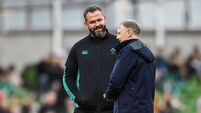The blame game: Ireland’s lineout, Paul O’Connell and the problem of determining responsibility

SCRUTINY: Assistant Coach Paul O'Connell. Pic: INPHO/Ben Brady
Watching various pros-turned-pundits come to terms with the need to be critical of one of the greatest rugby players this country has ever produced and their former team-mate has been an exercise in delicacy.
You couldn’t say they were holding back. You couldn’t say they were calling for his head, either.
“Something has to be done,” agreed Shane Horgan on the Second Captains podcast. “Something certainly has to be done. But whether jettisoning Paul O’Connell is the best move or not, I’m not sure. My instinct would be that it isn’t, but at the same time, the lineout hasn’t worked as well as it should.” And so it went.
“Jamie (Heaslip) and I have obviously played under Paul O’Connell,” said Stephen Ferris after the Japan win. “Everything is very complicated until it gets to game day, then you have a lineout menu and you stick to that lineout menu.”
Bernard Jackman told the national broadcaster that a new frontier had been reached: “I don’t think O’Connell has ever been under as much scrutiny as he has now and he is responsible for it.” Alan Quinlan explained on Off The Ball that it is not so much about the workman but the tools at his disposal: “Again, it is having a dominant lineout leader and caller. We don’t have that. You are patching together, trying to get other people better.” Underlying all of this is the oldest equation in team sport: if a certain unit misfires, the coach responsible takes the blame. Players have pointed to simple fixes such as an overthrow, miscommunication, the in-stadium audio, yet the persistence of the problem drains the power of continued explanation.
This is the reality of coaching in elite sport. It is endlessly complex. It is brutally simple. Ireland underperforming means someone, somewhere, is failing.
Is it as plain as this: lineout clears 90 per cent, O’Connell is succeeding; dip below that and he is not?
“Your total win percentage only tells part of the story,” says Duncan Casey, the former Munster hooker. He is deeply familiar with the process of detailed criticism having engaged in various media duties since retiring, including a column in these pages.
“That just means you retain possession. Internally, most teams would measure their lineout wins and the quality of the win as well. What I mean by that is, a quality lineout would be the receiver catching it, being able to deliver as intended to the scrum half and the pass away is clean.”
A pressing need to secure possession by the safest possible means has led to increased targeting of the front with their throw. The fact that they are working to address it naturally leads to opposition honing in on it.
There was a time when England opted not to compete and hit the maul on the ground, such was the fear of Ireland’s power. That is no longer the case. From the very first throw against New Zealand, when Dan Sheehan’s feed sailed past before Ryan Baird had even been lifted, the tone was set.
Modern rugby is driven by immense detail that makes it near impossible for any outfit to mask their weakness. In the Aviva Stadium, coaches can access four different camera views: behind the goals, sideline and a wide angle. Every team in the world has access to the same footage.
Analysts break down each throw by tracking numerous technical factors: Numbers, target, moves (a straight jump or a second move), action during lineout (off the top) and action after lineout.
That inspires specific strategies. Last weekend, Eddie Jones’ Japan repeatedly used a player less in the lineout. The first throw was six defenders versus seven. They did so to stack midfield with an extra forward and further blunt one of Ireland’s main sources of tries. That first lineout was still lost anyway.
There are two ways of looking at this sequence. A positive was that it was addressed at half-time. A negative was that it took until half-time and a coach’s intervention to solve it.
How much of this is the responsibility of the coach? Well, it’s complicated. There have been teams with terrific lineouts despite a poor coach. There have been Irish teams who have had to circumnavigate their coach, defying changes to a call system because of a perceived disruption.
Executing on the field is a collaborative process. A lot of moving parts moving in sync for the greater good. That is the essence of team sport.
“I know for sure that Paul O'Connell isn't the kind of guy who would come in and say, This is what we're running, you have to do this and not look for input or feedback from the guys who are actually going to be on the field calling the lineout,” says his former team-mate Casey.
“It would essentially be whoever's responsible for the line out, that might be one overall, but you might have an assistant forwards coach or whatever who would contribute too. But it's essentially the callers and the coaches setting line-out strategy.”

A host of the same players operated in a British and Irish Lions team that finished the three tests with an 86% retention rate. What does it say that their switch to the current Irish system has resulted in troubles? At the same time, when Andy Farrell took the mantle in 2020, there was a stern examination of their attack and repeated insistence by players that it was coming together.
Mike Catt bore the brunt of that frustration until they finally fired.
For a man who famously studied data with near-scholastic zeal during his playing career, to the extent he learned Afrikaans so he could interpret Springbok calls, O’Connell must now find a balance between tidying up the low-hanging fruit while introducing a curveball. The Wallabies arrive in Dublin knowing where they can hurt Ireland and with the armoury to do so.
Given that context, expect a calculated gamble at some point, like a long throw over the top to Stuart McCloskey. For Casey, the turn of the corner is approaching.
“I'd be surprised, I'd obviously be very disappointed, but I'd be surprised if we arrived at the end of the South African game with a continuation of the chatter that is here at the moment, which is that things are on the slide, things are going downhill, we have all of these problems basically and we need to make these changes.”
At this point, when the noise hits damaging levels, there is a comprehensive remedy. One thing for it.














